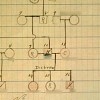
Colbert on Eugenics
Dec 3rd
Recently on The Colbert Report, in typically tongue in cheek fashion, “You-genics” was highlighted in “The Word” segment (October 28, 2009). Colbert’s discussion was tied in with our nation’s current health care debate – who is and isn’t coverable, what constitutes a pre-existing condition, and how to breed an insurable individual. Taken literally, Colbert’s words didn’t sound far off from those of proponents of the eugenics movement itself. Taken as intended, we see that a sense of humor can offer a unique perspective on anything.
Not surprisingly, eugenicists considered sense of humor as a trait to be studied, and the archive More >

Genetic Disorders Go B/Hollywood
Dec 1st
Remember Brad Pitt as Benjamin Button? Benjamin’s disorder, that had him being born looking like an 80-year-old man and “reverse aging” to pass away as a baby? Well, while I still am not aware of a real disorder that causes this kind of a phenomenon, there is a disorder that indeed makes people age much faster than normal: Hutchinson-Gilford Progeria Syndrome (Progeria for short), which is about to be depicted in a movie of its own.
Progeria is a very rare, genetic disorder that afflicts roughly one in 5 million people. It is caused by a mutation in the LaminA gene More >
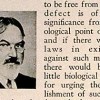
Hybrid Vigor in Corn and People
Nov 30th
The recent completion of the maize (corn) genome sequence gives us pause to think about the historical connection between agriculture and eugenics. It also causes us to consider why the leading American eugenicist, Charles Davenport, failed take greater stock in the corn research going on at one of several institutions he presided over at Cold Spring Harbor.
Especially in the United States, eugenics was firmly grounded in agriculture. Many of the leaders of the American movement had backgrounds in plant and animal breeding. For example, prior to becoming superintendent of the Eugenics Record Office (ERO) at Cold Spring Harbor, Harry Laughlin had More >

Autism and Marijuana
Nov 30th
This morning, “Good Morning America,” a popular morning news program in the U.S. told the story of a mother with an autistic child who was “treating” him with marijuana. I use quotation marks, and will make other cautionary notes here, because this blog is not meant to represent any forum of medical advice.
At the time of writing this, the GMA website, which usually posts follow-ups, has nothing on their site, which I found a little strange. The mother also appeared not with another member of her family, but a lawyer, who was also a family friend. I wondered how these More >

Six Tips on Avoiding Cancer
Nov 30th
Most of us know that smoking cigarettes and excess exposure to the sun can increase the risk of getting cancer. In fact, much of cancer can be avoided by changing behavior. For examples of some causes of cancer, check out Inside Cancer. Some of the causes of cancer are less obvious. An example is maintaining a healthy weight. Did you know that overweight people are 50% more likely to die of cancer than those with normal body weight? In the United States, this means each year about 90,000 people die of cancer that could be prevented if we could all More >
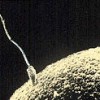
Some Cells Have 23 Chromosomes
Nov 25th
It is a game of chance! With one spin of a wheel, X and Y chromosomes, represented by pink (X) and green ping-pong balls (Y), are passed from each parent to a child. When the wheel stops, the baby is either a boy or a girl – depending on which chromosomes were inherited. It is a simple, yet powerful tool that demonstrates basic chromosomal inheritance. It is easy to see that every time the wheel is spun, there is a 50/50 chance of having a boy or a girl.
Demonstrations with this wheel have led to some very interesting student responses and questions. I have More >

Forensics in the classroom
Nov 23rd
It is important as teachers to incorporate subject matter that is of interest to your students. This will get them more excited about the process of learning. Recently, I have seen an ever growing interest in forensic science, with the help of the media. This offers valuable teaching opportunities. Almost every student that I have encountered has seen at least one episode of CSI or Law & Order.
So how can you take this material from the television screen into the classroom? Using the applications of DNA testing alone can provide you with a wide range of lessons, including the use of DNA More >
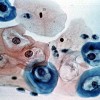
HPV twist?
Nov 17th
Human Papilloma Virus (HPV) is a family of small, non-enveloped DNA viruses which infect epithelial cells, and of which there are over 100 subtypes. HPV is divided into two major categories, high risk types which includes types 16, 18, 31. 33, 35. 39, 45, and low risk types 6 and 11. HPV 16 is implicated in over 90% of cervical cancers and shown to be a causal factor in the development of the disease. HPV produces two oncoproteins, E6 and E7, which inactivate the cellular tumor suppressor proteins, p53 and pRB respectively. This allows it to disable two of the More >

Your teacher was wrong!
Nov 12th
I studied neuroscience in college and subsequently taught it for three years at university. One of the central tenants of the course I studied and taught was the dogma of synaptic transmission. The basic tenant of this dogma is that neurons communicate exclusively by sending chemical signals across the synaptic cleft. Pretty much every neuroscience textbook ever written is filled with this idea. It turns out that this is not actually the whole truth. To communicate, brain cells do not need a synapse at all!
This is the surprising news from a team of researchers are the University of Szeged, Hungary. More >
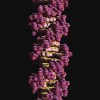
Does New DNA Always Mean New Traits?
Nov 10th
I was teaching a class of fifth grade students last week and we were discussing the characteristics of DNA and cells. As a group, we described how the human body is made up of a variety of cell types, including muscle cells, nerve cells, and more. I explained that although cells can be diverse in their appearance and functions, within one organism they all have the same DNA (except for mature red blood cells and gametes). The reason that a nerve cell is different from a bone cell is simply that they use different recipes in different ways.
A student then More >
